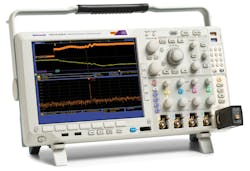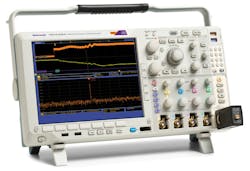This file type includes high resolution graphics and schematics when applicable.
High-frequency engineers in need of time- and frequency-domain analysis of different signals typically reach for two instruments: a high-speed oscilloscope and a broadband spectrum analyzer. Or at least, that’s what they do if they don’t have access to an MDO4000B test instrument from Tektronix. Introduced several years ago, these instruments brought new levels of measurement productivity to the test bench by integrating a spectrum analyzer with a digital storage oscilloscope (DSO), resulting in a mixed-domain oscilloscope (MDO). The product line has been well received and was recently enhanced and expanded, with spectrum analyzer frequency coverage now available across a range as wide as 9 kHz to 6 GHz.
This combination of two popular measurement instruments makes it possible to correlate signals in the frequency domain with the time-domain events that may have caused them. The display screen can show two views of a signal at the same time, with a traditional oscilloscope screen on the top half and a spectrum analyzer display on the bottom. The spectrum analyzer includes its own acquisition system, allowing it to act as a separate instrument (from the oscilloscope) within a common housing. When the time and frequency domains are displayed, the displayed signals are time correlated, triggered by the system trigger event. When just the spectrum analyzer is used, it can be set to “Free Run” for continuous measurements unrelated to the time domain.
The MDO4000B series of high-speed, high-frequency test instruments (see photo) can capture and display time-correlated analog, digital, and RF/microwave signals to provide comprehensive analysis of the most complex signals. All models provide four analog input channels, with analysis bandwidths ranging from 100 MHz to more than 1 GHz per channel (see table). All models offer sampling rates of at least 2.5 GSamples/s per channel, with sampling rates to 5 GSamples/s available on the top two models.
The spurious-free-dynamic-range (SFDR) performance of this latest generation of MDO4000B MSOs has been boosted by about 5 dB from the original line of MDOs, now providing SFDRs of -65 dBc. The phase-noise performance of the analyzers has been improved by as much as 20 dB compared to the earlier MDO4000 models, allowing for enhanced phase-noise analysis and close-in spurious measurements. The new analyzers’ maximum RF acquisition time has been doubled over the original line of instruments, from 79 ms to a current capability of 158 ms, enabling capture of complex signals and modulated signal bursts.
Extending the lower-frequency limit of the spectrum analyzers, from 50 kHz to 9 kHz, also is a benefit for those involved in diagnosing electromagnetic-interference (EMI) issues. In addition, when used with the SignalVu-PC test software from Tektronix, the MDO4000B MDOs offer extremely wide-bandwidth vector-signal-analyzer (VSA) capability (greater than 1 GHz)—ideal for testing modern wireless-local-area-network (WLAN) systems.
To aid computer hookups and other digital connections, each MDO4000B includes two USB 2.0 host ports on the front panel and two on the rear panel, with a USB 2.0 device port on the rear panel for connection to a PC. Each instrument also provides an Ethernet port for network connections. The instruments are available with optional applications support for VSA measurements, advanced RF triggering, power analysis, limit and mask testing, and high-definition-television (HDTV) and custom video analysis. P&A: starting at $12,400 (USD).
Tektronix, Inc., 14150 SW Karl Braun Dr., P.O. Box 500, Beaverton, OR 97077; (800) 833-9200.
This file type includes high resolution graphics and schematics when applicable.
About the Author
Jack Browne
Technical Contributor
Jack Browne, Technical Contributor, has worked in technical publishing for over 30 years. He managed the content and production of three technical journals while at the American Institute of Physics, including Medical Physics and the Journal of Vacuum Science & Technology. He has been a Publisher and Editor for Penton Media, started the firm’s Wireless Symposium & Exhibition trade show in 1993, and currently serves as Technical Contributor for that company's Microwaves & RF magazine. Browne, who holds a BS in Mathematics from City College of New York and BA degrees in English and Philosophy from Fordham University, is a member of the IEEE.



